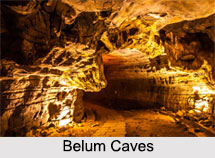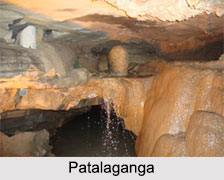 The Belum Caves is located at Belum Village in Kolimigundla Mandal of Kurnool District in State of Andhra Pradesh, India. It is regarded as the second largest cave in Indian subcontinent after the Meghalaya Caves. Named after the ancient Sanskrit word, Belum, these caves are about 320 kilometres away from Hyderabad. These caves were formed by the action of water flowing on limestone dumps over millions of years, forming stalactites, stalagmites, siphons and sink holes.
The Belum Caves is located at Belum Village in Kolimigundla Mandal of Kurnool District in State of Andhra Pradesh, India. It is regarded as the second largest cave in Indian subcontinent after the Meghalaya Caves. Named after the ancient Sanskrit word, Belum, these caves are about 320 kilometres away from Hyderabad. These caves were formed by the action of water flowing on limestone dumps over millions of years, forming stalactites, stalagmites, siphons and sink holes.
The total length of the cave is 3,229 metres and it goes as deep as 46 metres at one point within the cave, which is well-known as "Pataalaganga". The composed 40 feet Buddha statue built here by the Andhra Pradesh Tourism Development Corporation (APTDC) is a stunning symbol of the function of the monks in the history of these caves. Belum caves were also considered the best destination award 2002 at the Tourism and Travel Fair held in Bengaluru in 2002.
Location of Belum Caves
Belum Caves are situated at 275 kilometres away from Bengaluru approximately, in the Kurnool district of Andhra Pradesh.
History of Belum Caves
In the 1980s, Indian officials worked with a German team to survey and map the caves. The historical objects found in the caves dated back to around 4500 BC and showed that the caves had been colonized by the ancient Buddhist and Jain monks. These relics are now stored in Museum at Ananthapur. In 1999, the Andhra Pradesh Tourism Development Corporation took over the caves for maintenance.
They cleared the dirt and ruins surrounded by, built pathways, provided lighting and sank airing shafts to make the caves nearby to the public. Though these caves were recognized to the locals for thousands of years, the first official records that mention them are from 1884, by Robert Bruce Foote who was a British geologist and archaeologist.
Construction of Belum Caves
A division of the doorway chamber is called "Gebauer Hall", after the German speleologist Mr H. Daniel Gebauer, who explored and mapped the caves in 1982/83. The black limestone caves of Belum have a mess of 16 vast paths with limited ventilation and under fresh water. A hole in the ground of the entrance of the caves makes this hidden gem reachable to adventure seekers.
The grand natural sculptures of the caves include the "Simhadwaram", "Kotilingalu Chamber", "Voodalamari" and "Thousand Hoods". A striking geological feature, the sinkholes of the caves is a beautiful sight. It was created by the movement of subterranean water. One of the most remarkable features here is the "Saptasvarala Guha" where the stalactite formations create the musical sounds when struck with a wooden stick.
There is a continuing underground watercourse which forms a natural waterfall at the lowest point in the caves around 150 feet below earth level. It is called "Patalganga". Centuries ago, Jain and Buddhist monks meditated in the jumbles of these caves known as "Dhyana Mandir". An interesting shape at the "Dhyana Mandir" looks like a bed with pillow. The local myth has it that in ancient times the caves were a home to many sages who used the gray stone recliner as a bed. There is a Banyan Tree Hall which has a vast pillar with stalactites hanging from the ceiling. This gives a glance of Banyan Tree with its mid-air roots. The local people call it "Voodalamari".
Visiting information of Belum Caves
The nearest railway station is Tadipatri, 30 kilometers away. There are daily trains from Delhi, Mumbai, Chennai, Hyderabad, Tirupati, Kanyakumari, Thiruvananthapuram, Coimbatore and Goa which stop at Tadipatri railway station. From Tadipatri, people can take a bus to the Belum Caves.



















